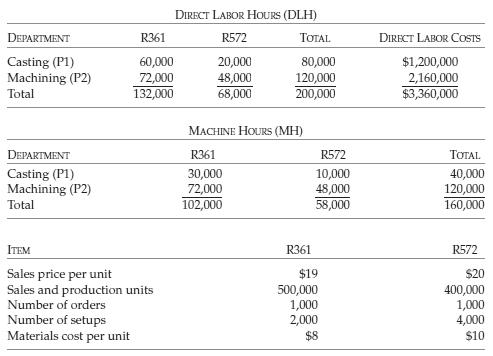Reference no: EM13507016
Comparison of two costing systems, original activity-based costs, implementing change The Redwood City plant of Crimson Components Company makes two types of rotators for automobile engines: R361 and R572. The old cost accounting system at the plant traced support costs to four cost pools:

Pool S1 included service activity costs related to setups, production scheduling, plant administration, janitorial services, materials handling, and shipping. Pool S2 included activity costs related to machine maintenance and repair, rent, insurance, power, and utilities. Pools P1 and P2 included supervisors' wages, idle time, and indirect materials for the two production departments, casting and machining, respectively.
The old accounting system allocated support costs in pools S1 and S2 to the two production departments using direct labor cost and machine hours, respectively, as the cost drivers. Then the accumulated support costs in pools P1 and P2 were applied to the products on the basis of direct labor hours. A separate rate was determined for each of the two production departments. The direct labor wage rate is $15 per hour in casting and $18 per hour in machining.

Now the plant has implemented an activity-based costing system. The following table presents the amounts from the old cost pools that are traced to each of the new activity cost pools:

Setups for R572 are 50% more complex than those for R361; that is, each R572 setup takes 1.5 times as long as one R361 setup.
Required
(a) Determine the product costs per unit using the old system. Show all intermediate steps for allocations, including departmental cost driver rates and a breakdown of product costs into each of their components.
(b) Determine the product costs per unit using the new system.
(c) Explain the intuitive reason that the product costs differ under the two accounting systems.
(d) What should Crimson Components do to improve the profitability of its Redwood City plant? Include marketing and product-related changes among your recommendations.
(e) Describe how experienced production and sales managers are likely to react to the new product costs.
|
How many units must peerless company sell to earn a profit
: What is the breakeven point in (a) sales units and (b) sales dollars - how many units must Peerless Company sell to earn a profit of $600,000 per year?
|
|
What is the potential difference across the membrane
: The electric field within the membrane separating the inside and outside of a biological cell is approximately 7.8MV/m, what is the potential difference across the membrane
|
|
Explain the molar solubility of the sulfide in water
: A metal sulfide, M2(CO3)3, has a Ksp of 8.75 x 10^-42. What is the molar solubility of this sulfide in water. Assume the sulfide dissolves ideally (ignore hydrolysis effects).
|
|
Estimate the tension in the cord
: block A which is 19.3 N is placed on a frictionless ramp that is inclined at 15 degrees. Block B which is 15.7 N is placed on top of the block, estimate the tension in the cord
|
|
Determine the product costs per unit using the old system
: Determine the product costs per unit using the old system. Show all intermediate steps for allocations, including departmental cost driver rates and a breakdown of product costs into each of their components.
|
|
Find the electric flux through one face of the cube
: A 4.6muC charge is at the center of a cube 6.5 cm on each side. What is the electric flux through one face of the cube
|
|
Explain what is the ka for the acid
: A 0.1276 g sample of a monoprotic acid (molar mass=1.10 x 10^2) was dissolved in 25 mL of water and titrated with 0.0633 M NaOH. After 10 mL of base had been added, the pH was determined to be 5.87. What is the Ka for the acid
|
|
Calculate the electric flux through the sphere
: A 7.4muC charge and a -4.3mC charge are inside an uncharged sphere. What is the electric flux through the sphere
|
|
What is restraint of trade
: What is Restraint of Trade, Federal Trade Commission, Sherman Antitrust Act, and Risk Management?
|